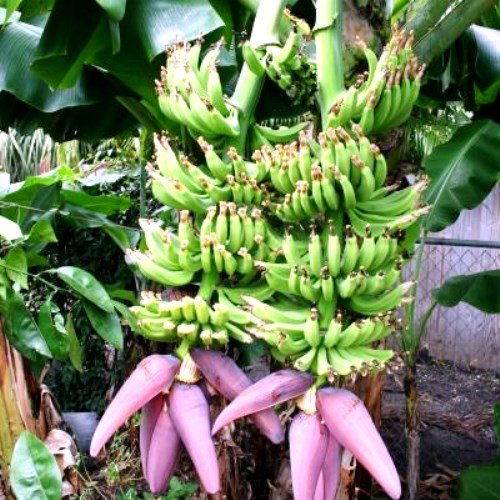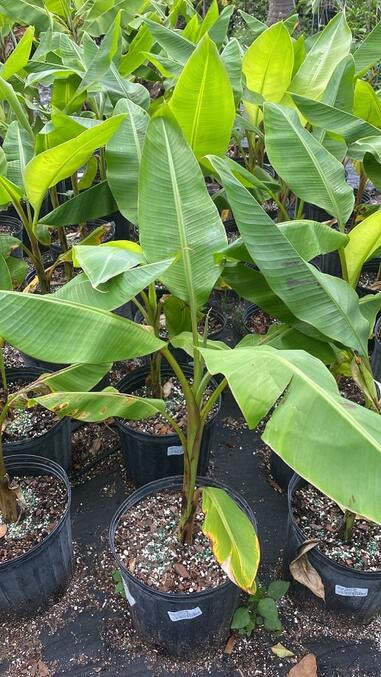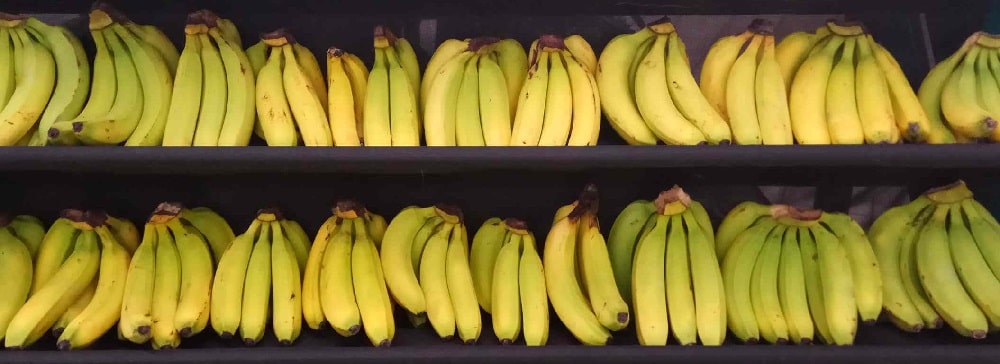BANANA CULTIVARS
There are hundreds of different cultivars of bananas around the globe. Below is a list of Banana Cultivars (plant varieties) that can be found for sale at Fox Hill Nursery.
Double Mahoi Bananas'Double Mahoi' is a sport or mutation of the common 'Dwarf Cavendish' and grows similarly. This cultivar usually produces a single head of fruit in the first season, but in successive seasons will almost always produce two large heads of fruit and can occasionally produce a third. This is a rare and unusual Musa. 'Double Mahoi' can grow double stalks on the first year. The bananas are sweet dessert quality, and the plant is very productive and a fast grower. Grows 6’ to 8’ in height.
|
Grand Nain BananasGrand Nain bananas are banana cultivars of Musa acuminata. It is one of the most commonly cultivated bananas and a member of the commercial Cavendish banana cultivar group. It is also known as the Chiquita banana because it is the main product of Chiquita Brands International. Grows 8’ to 10’ in height. Grand Nain is French for Great Dwarf, although it is more of a midsized plant in our region.
|
Goldfinger Bananas
A recent product of the banana breeding program in Honduras, this cultivar has commercial potential. It has a high wind resistance and excellent disease resistance with a strong pseudostem and base. It is an outstanding producer of delicious tasting bananas that are reminiscent of one of its parents (Musa "Dwarf Prata"/"Prata Ana"/ "Dwarf Brazilian"...these are all synonyms). The other parent cultivar is SH3142. It is a rapid growing, easy to grow, mostly green plant. Planted in the ground it grows to about 10-12 Ft with stout construction and broad leaves with fruit clusters in the 30-100 Lbs bunches. It is the first product of the banana improvement research project of Fundacion Hondurena de Investigation Agricola. This variety produces superior fruit considered among the tastiest. It is slightly sub-acid with an excellent apple-flavor, especially when fully ripe. The fruit gets 6-8 inches long or better.
This new and distinct variety of banana plant has the following unique combination of desirable features:
1. High level of resistance to both the yellow Sigatoka leaf spot disease (Mycosphaerella musicola) and the black Sigatoka leaf spot disease (Mycosphaerella fijiensis).
2. Practical immunity to both races 1 and 4 of Panama disease (Fusarium oxysporum f. sp. cubense).
3. A strong root system which makes it a hardy plant under marginal water and soil conditions.
4. Excellent green life of fruit after harvest which renders it suitable for export.
5. Sliced or diced green and ripe fruit does not oxidize to an unsightly brownish color as does the fruit of the Cavendish export clones.
6. Pleasant slightly tart flavor when ripe.
This new and distinct variety of banana plant has the following unique combination of desirable features:
1. High level of resistance to both the yellow Sigatoka leaf spot disease (Mycosphaerella musicola) and the black Sigatoka leaf spot disease (Mycosphaerella fijiensis).
2. Practical immunity to both races 1 and 4 of Panama disease (Fusarium oxysporum f. sp. cubense).
3. A strong root system which makes it a hardy plant under marginal water and soil conditions.
4. Excellent green life of fruit after harvest which renders it suitable for export.
5. Sliced or diced green and ripe fruit does not oxidize to an unsightly brownish color as does the fruit of the Cavendish export clones.
6. Pleasant slightly tart flavor when ripe.
Kokopo Bananas‘Kokopo’ is a Musa acuminata hybrid with fantastic orange-pulp. It is a short-season banana plant that grows quickly. Bloom to harvest time is 5 to 6 weeks, which makes it perfect for that last-minute tropical harvest. If planted in the spring, it will produce fruit by the summer. In addition, it makes a great indoor banana plant, growing fairly thin and lightweight compared to other Musa varieties. This cultivar originates in Papua New Guinea, where almost half of the population is self-sustained. That’s a good testament to the hardiness, success, and versatility of the Kokopo banana. The ‘Kokopo’ banana fruit is unusual in that it holds orange pulp, which is a sign of high vitamin A and beta carotene content. This cultivar can start fruiting at 5’ to 6’ in height.
|
Lacatan (Lakatan) BananasClaimed to be the best tasting banana, the ‘Lakatan’ is a popular Filipino cultivar with harvestable fruit in 8 to 12 months. The fruit has a sweet taste and aroma, and the plant can bear at 6’ to 10’ in height. Musa 'Lakatan' is desirable for desert bananas because of their sweet taste, aroma, and firm texture when ripe. They are preferred to Cavendish varieties in their native region of the Philippines. The fruit gets a more orange hue than Cavendish types and it is high in beta carotene, with a sweet and fragrant flavor. Rare in our region, it is a highly desirable cultivar.
|
Truly Tiny Bananas
|
Musa ‘Truly Tiny’ Super Dwarf Banana Plant is the smallest edible fruit producing banana in the world. ‘Truly Tiny’ banana is a small yard owners dream banana. It will not take over your yard or landscape due to its size. A delicious edible dwarf Cavendish type banana that puts out good sized bananas. Leaves have reddish wine spots/variegation. Extremely dwarf banana edible banana with red variegation. High wind resistance. This banana fruits at 3’ to 4’ in height. This is a must have banana for windy locations or small yards.
|









